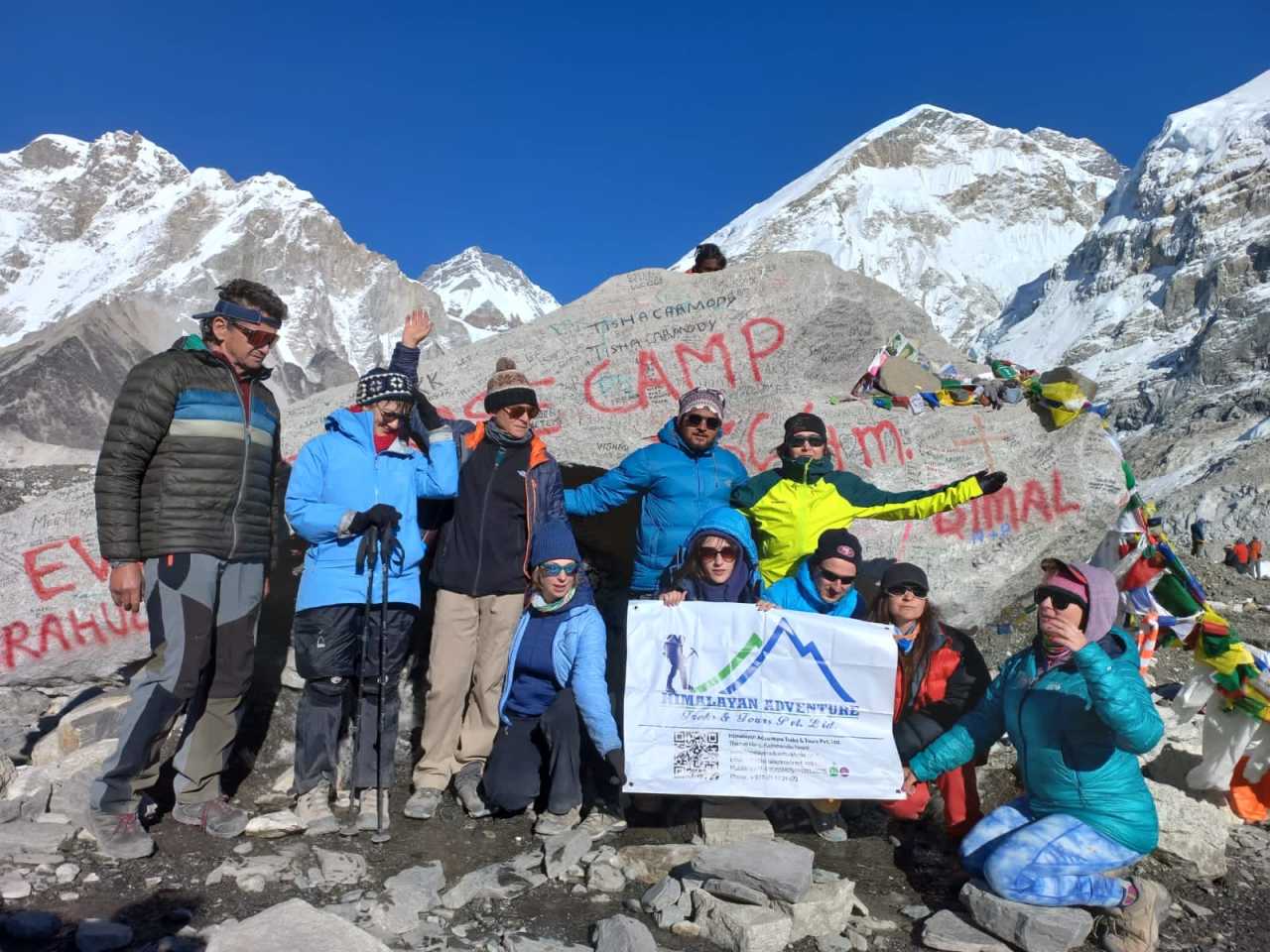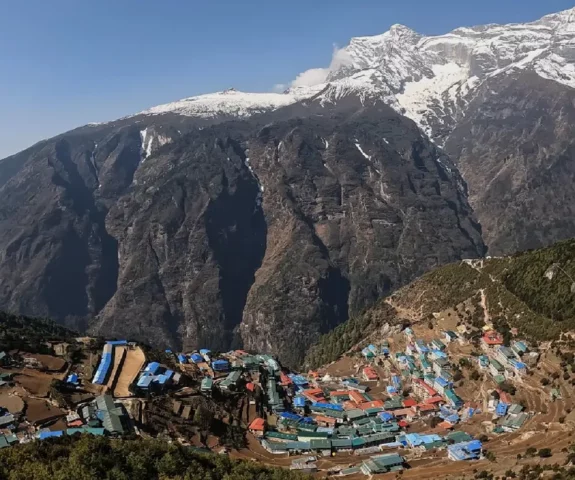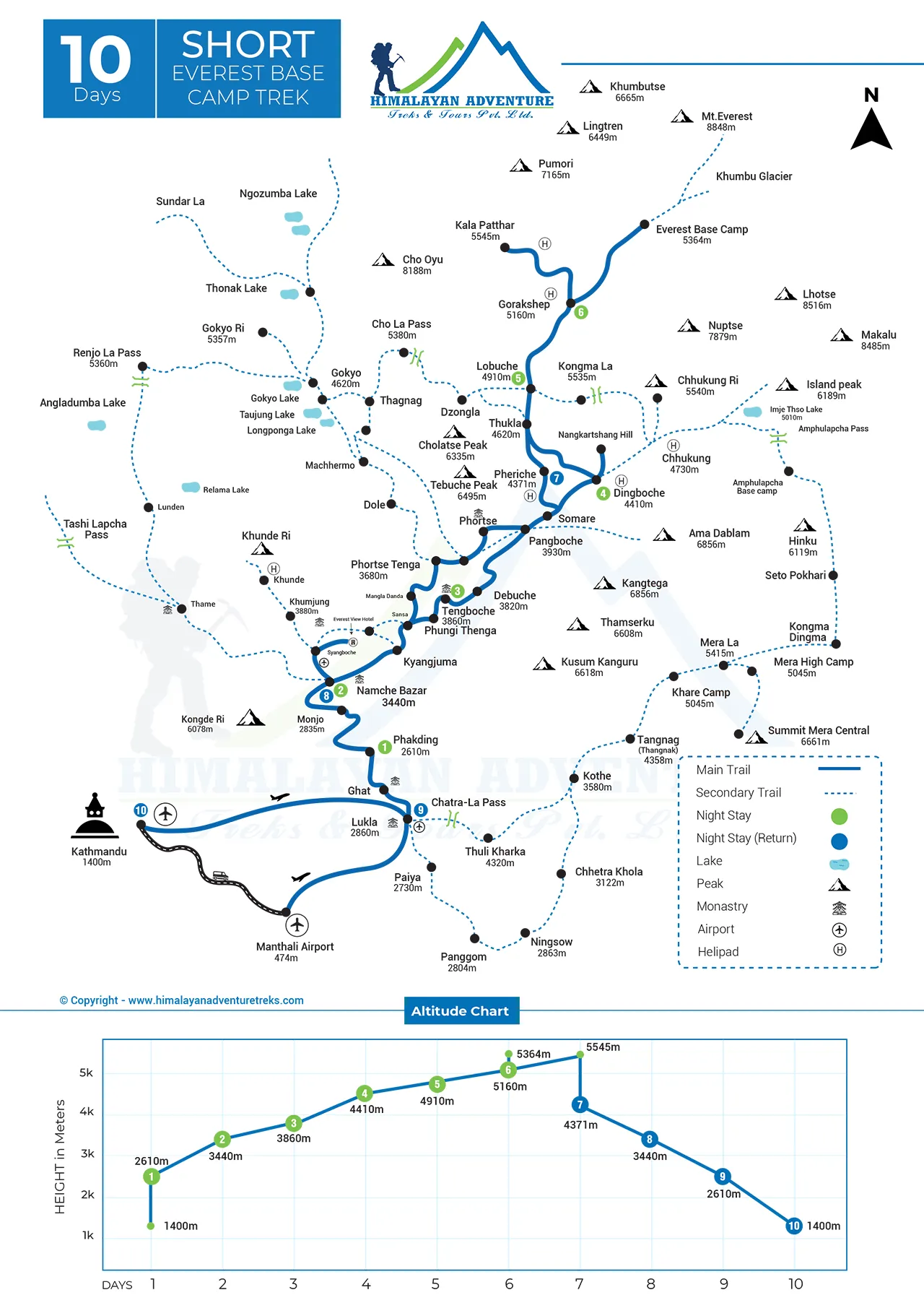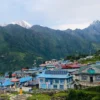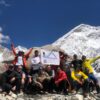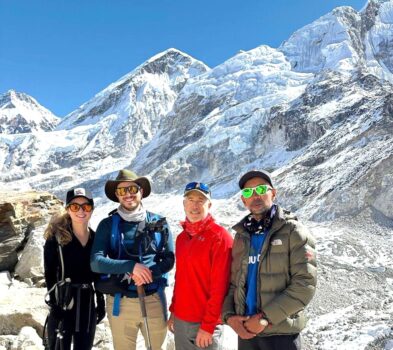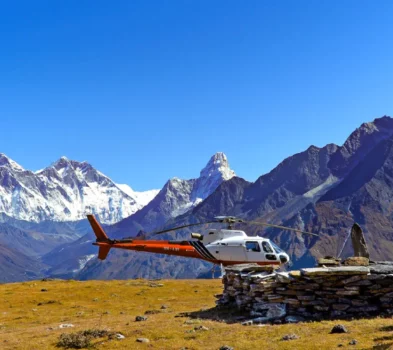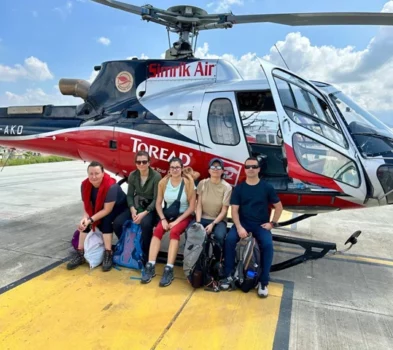Duration
10 DaysShort Everest Base Camp Trek
Trip Grade
ModerateGroup Size
1-16 PeopleMax Altitude
5,545m. / 18,192ft.Best Season
Feb- May/ Sept-NovActivity
Trekking & HikingMeals
Breakfast, Lunch & DinnerAccommodation
TeahousesTransportation
Flight & Private VehicleTrip Customization
On request (click here)Highlights of Short Everest Base Camp Trek
- Kicking off Short Everest Base Camp Trek journeywith a breathtaking flight to Lukla with stunning views of the Himalayas
- Passing through the Sagarmatha National Park, a UNESCO World Heritage Site that is home to sparse plants and animals
- Witnessing the world’s deepest glacier, Khumbu Glacier
- Exploring the Tengboche Monastery, which holds a spiritual value and is an iconic cultural landmark
- Summiting EBC at 5364 meters and enjoying panoramic sunrise views from Kala Patthar (5,545m)
- Admiring iconic mountains like Everest, Nuptse, Lhotse, and Ama Dablam throughout the trek
- Fall and spring are the best seasons to enjoy this 10-day Everest Base Camp Trek adventure with manageable physical challenges
Trip Introduction
The Short Everest Base Camp Trek has always been a once-in-a-lifetime, illustrious journey in the lap of some of the highest Himalayas in the globe. The EBC trek is Nepal’s famed trail where paradise’s mythical beauty encounters the out-of-this-world reality of Everest’s regional landscape.
The 10-day Short Everest Base Camp Trek also comprises Makalu Barun National Park and Sagarmatha National Park, which are both known for high-altitude protected areas. Similarly, Sagarmatha National Park is also one of the UNESCO World Heritage Sites, listed in 1979 with an outstanding inscription, where you can see rare wildlife and plants with unique natural beauty.
The Everest Short Trek itinerary gateway will take you through luxuriant forests, glacial streams, small charming settlements, hanging suspension bridges, and many more than you expected, leaving you stunned with its alluring scenery. It is more than just a regular hike; it’s an awesome exposure to nature and a chance to connect with the dignified ice-capped peaks.
This journey will get underway with a picturesque flight to Lukla Town from Nepal’s dynamic capital city, Kathmandu, touching down at 2860 meters, or 9383 feet, in the Khumbu region. Depending on the Everest base camp weather, the flight either departs from Manthali/Ramechhap or Tribhuvan International Airport.
This short Everest Trekking journey will continue with a short trek to Phakding Village and then to the Namche Bazaar, which is the main trading destination of the Everest region, on the next day. You will also get to visit the largest monastery in the region, Tengboche Monastery, which holds religious and spiritual importance to local people.
From there, your Short Everest base camp itinerary route will take you to the classic villages of the Everest region, such as Dingboche (4410 m), Lobuche (4940 m), and eventually Gorak Shep (5140 m). Your next two important stops of the excursion will be at Everest Base Camp and Kala Patthar.
Trekkers can bask in the glory of both EBC and Kala Patthar with the iconic vistas of panoramic snow-covered mountains like Everest, Nuptse, Ama Dablam, and Lhotse with 360-degree views, which are worth every single Everest base camp difficulty that you faced while hiking.
Furthermore, the Short Everest Base Camp Trek adventure will provide you with a unique opportunity to observe the world’s deepest glacier, the Khumbu Glacier. Afterward, your path will retrace back through Pheriche, Tengboche, and Namche, traversing through the same route before reaching Lukla town, ending the trip in Kathmandu city.
The Short Everest Base Camp Trek cost package is quite reasonable, and it can be done in 10 days with modest physical ability. Apart from this, the perfect arrangement of the Everest base camp best seasons is fall and spring. This walk allows you to immerse yourself in natural beauty while also learning about the Sherpa people’s rich culture.
Outline Itinerary of Short Everest Base Camp Trek
Day 01: Fly from Kathmandu to Lukla (2860 m/ 9383 ft) and Trek to Phakding (2610 m/ 8563 ft).
Day 02: Trek from Phakding to Namche Bazaar (3440 m/ 11,286 ft).
Day 03: Trek from Namche to Tengboche (3860 m/ 12,664 ft).
Day 04: Trek from Tengboche to Dingboche (4410 m / 14,469 ft).
Day 05: Trek from Dingboche to Lobuche (4940 m/ 16,210 ft).
Day 06: Trek from Lobuche to Gorakshep (5140 m) and Summit to Everest Base Camp (5364 m).
Day 07: Hike from Gorakshep to Kalapatthar (5545 m) & Trek from Gorakshep to Pheriche (4371 m).
Day 08: Trek from Pheriche to Namche (3440 m/ 11,286 ft).
Day 09: Trek from Namche to Lukla (2860 m/ 9383 ft).
Day 10: Fly from Lukla to Kathmandu (1400 m /4600 ft).
Our guests sharing their experiences (Photo/Video Gallery)
Detail itinerary of Short Everest Base Camp Trek
Day 01: Fly from Kathmandu to Lukla (2860 m/ 9383 ft) and Trek to Phakding (2610 m/ 8563 ft).
On day 1 of our Short Everest Base Camp Trek, we will get up and travel to the airport. Our next 35 minutes will be spent flying to Tenzing Hillary Airstrip. Experience stunning and exhilarating views from above the Everest region via plane.
Then, we will gather with the rest of our Everest Base Camp Trekking Guide team to start the hiking journey. We will eat breakfast in Lukla and walk towards Phakding village.
We will walk through passing many rivers, lush jungles, hanging arches, and charming villages. After walking a length of 8 kilometers, we will arrive at Phakding, where we will sleep the night on this Everest Base Camp Short Trek.
Activity: Flight & Trek, 4-5 hours
Max. Altitude: 2,860m/9,383ft. Phakding
Meal: Lunch & Dinner
Accommodation: Teahouse
Day 02: Trek from Phakding to Namche Bazaar (3440 m/ 11,286 ft).
As we go to Namche Bazaar, the center of the Sherpa district, we expect Everest base camp weather to be beautiful today. Our trail is going to be a steady uphill. We will walk through different settlements, such as Monjo and Jorsale. There we will set foot in the park of Everest region called Sagarmatha National Park.
You may witness a variety of vegetation, including pine and rhododendron trees. You may also spot some of the beautiful wildlife. If you are an animal lover, you may enjoy watching the activities of animals in the park. Then, we will walk above Dudh Koshi Khola via a hanging bridge.
After going for five to six hours, we would get here at the Namche Bazaar. Banks, ATMs, schools, businesses, cafes, and hospitals are among the development facilities available here. On this Short Everest Base Camp Trek adventure, we will spend the night here and indulge in great cuisine.
Activity: Trek, 5-6 hours
Max. Altitude: 3,440m/11,286ft. Namche Bazaar
Meal: Breakfast, Lunch & Dinner
Accommodation: Teahouse
Day 03: Trek from Namche to Tengboche (3860 m/ 12,664 ft).
Today we are going to Tengboche from Namche Bazaar on this 10-day Everest Base Camp Trek itinerary after breakfast. If you need any trekking gear, you can buy it in Namche shops, as there will be no shops in other places where we will be heading in the upcoming days.
You can experience the beautiful Everest base camp weather while walking and enjoying the best views. We will walk past Sanasa village, leading us to Lawi Schyasa and Tashing before crossing the Dudh Koshi River. After walking for a few hours, we will reach Phunki Tenga. Then, we proceed to climb towards Tengboche.
After reaching this place, we will go to visit the oldest and most holy monastery in the Everest region, called Tengboche Monastery. Then, we will check out in the teahouse where we will spend the night on this Short Everest Trekking journey.
Activity: Trek, 5-6 hours
Max. Altitude: 3,860m/12,664ft. Tengboche
Meal: Breakfast, Lunch & Dinner
Accommodation: Teahouse
Day 04: Trek from Tengboche to Dingboche (4410 m / 14,469 ft).
On day 4 of this thrilling journey, our journey continues on the way to Dingboche village, which sits at a height of 4410 meters, or 14,469 feet, above ocean level. We will hike, crossing the Imja Khola River, which will lead towards the rugged landscape of the mountains.
On this day of the Short Everest Base Camp Trek adventure, we will cross numerous suspension bridges and walk through small Sherpa hamlets such as Pangboche and Orsho. On your route, you will experience clear Everest base camp weather with thinner air due to altitude levels higher than 4000 meters.
After hiking for almost five to six hours, covering a distance of approximately 12 kilometers, we will lastly reach our final destination of the day. Dingboche village. The Khumbu region’s Summer Valley is another name for this settlement. We will spend an overnight in this village on this Short Everest Trekking tour of 10 days.
Activity: Trek, 5-6 hours
Max. Altitude: 4,410m/14,469ft. Dingboche
Meal: Breakfast, Lunch & Dinner
Accommodation: Teahouse
Day 05: Trek from Dingboche to Lobuche (4940 m/ 16,210 ft).
Our final stop will be at Lobuche Village before conquering the EBC on this Short Everest Base Camp Trek journey. We will depart from Dingboche Village after having a hearty breakfast. We first start walking uphill in the direction of Thukla Village. You can also see the beautiful vistas of Mount Cholatse and Mount Taboche.
We will pass via Thukla Pass, where you can see the stone memorials of late mountaineers, which are draped with colorful prayer flags to honor those who tragically lost their lives. We will walk to Lobuche in five hours. We stay here overnight to complete today’s journey on this 10-day Everest base camp trek itinerary.
Activity: Trek, 5-6 hours
Max. Altitude: 4,940m/16,207ft. Lobuche
Meal: Breakfast, Lunch & Dinner
Accommodation: Teahouse
Day 06: Trek from Lobuche to Gorakshep (5140 m) and Summit to Everest Base Camp (5364 m).
On this sixth-day Everest Base Camp Short Trek adventure, we are finally going to the highlighting place of this whole trip. We have 2 primary destinations to reach on this today’s hike excursion: Gorak Shep and Mount Everest Base Camp (EBC). At the first flush of the morning we get ready for our trek.
First, we’ll have a delicious breakfast in Lobuche before embarking on our climb. We will hike along the Khumbu Glacier routes, taking in the spine-tingling vistas of the massive peaks. Here, we will leave our backpacks in the teahouse and proceed to hike towards Everest Base Camp.
Apparently to thisShort Everest Trekking excursion, the route to EBC is difficult and rocky. Along the route, you can take in the breathtaking vistas of Khumbu Glacier and Icefall. You will be treated to close-up breathtaking views of Mount Everest, Khumbuste, Lhotse, Pumori, and other breathtaking Himalayas once you arrive at the base camp.
After enjoying sometime in the EBC, we would go back to Gorak Shep for one more night sleep over. You should sleep early and rest properly for tomorrow’s next big day on this 10-day Everest base camp itinerary.
Activity: Trek, 6-7 hours
Max. Altitude: 5,140m/16,864ft. Gorakshep
Meal: Breakfast, Lunch & Dinner
Accommodation: Teahouse
Day 07: Hike from Gorakshep to Kalapatthar (5545 m) & Trek from Gorakshep to Pheriche (4371 m).
On this Everest Short Trek excursion, our goal for today is to witness the breathtaking dawn from Kala Patthar. Kala Patthar is also the highest place in this entire Everest Base Camp Short Trek adventure. We will leave Gorak Shep before the beginning of the day so that we don’t miss the sunrise.
We will ascend in rugged terrain for one and a half hours to reach the Kala Patthar. There you can see the sunrise casting its golden light on the ice-capped mountains, which is truly going to be mesmerizing on this Short Everest Base Camp Trek journey. After soaking in the beauty of the landscape, we would move back down to Gorak Shep.
There we will eat our hearty breakfast and then continue to trek towards Pheriche. At this time, the Everest base camp weather will also be very amazing, adding charm to the hike. We will stroll through Lobuche, enjoying the wonderful scenery on the way.
Today, we would have walked around for roughly a total of 7 to 8 hours to reach Pheriche, where we will spend the night on this Everest Short Trek adventure excursion.
Activity: Hike & Trek, 7-8 hours
Max. Altitude: 5,545m/18,192ft. Kalapatthar
Meal: Breakfast, Lunch & Dinner
Accommodation: Teahouse
Day 08: Trek from Pheriche to Namche (3440 m/ 11,286 ft).
On this day 8 of theShort Everest Base Camp Trek, we will retrace Namche Bazaar following the same route we used before. This day will be one of the longer days ofShort Everest Trekking. Even though we are returning home, the journey will still be as pleasant as before, offering the majestic peaks as our backdrop.
We will start walking downhill to Dughla from Pheriche on this Everest base camp itinerary, continuing past Orsho and Somare. Then, we will pass through Pangboche village to experience the Everest base camp best season, following the swift-flowing Imja Khola River to Deboche.
From this village on thisShort Everest Base Camp Trek, the path will be full of green jungles down to the Phunki Tenga, where we will catch the Dudh Koshi River again. Then, the final stretch would be to Tengboche Monastery before reaching Namche Bazaar on this beautiful Everest base camp best season adventure.
After walking for eight to nine hours, we will finally reach the Namche Bazaar, where you can enjoy all the amenities once again on this Short Everest Trekking. You can unwind by visiting pubs, cafes, or restaurants. We will stay overnight and head back to Lukla tomorrow on this 10-day Everest Base Camp Trek journey.
Activity: Trek, 8-9 hours
Max. Altitude: 3,440m/11,286ft. Namche
Meal: Breakfast, Lunch & Dinner
Accommodation: Teahouse
Day 09: Trek from Namche to Lukla (2860 m/ 9383 ft).
On Day 9 of the Short Everest Base Camp Trek, we will return to Lukla from Namche Bazaar Town. Today’s trek will be longer, involving 7 to 8 hours of walking. We will be parting from Namche Bazaar soon after a hearty breakfast. You can take one more look at this wonderful town before we resume our adventure.
We will hike along the same path we took to reach Namche from Lukla. You can also enjoy the final glimpse of Mt. Everest before it disappears. We will continue descending alongside the Dudh Koshi Khola River, crossing several suspension arches to reach the faltering terrain.
This short Everest Base Camp trek will only have some uphill sections, as we will primarily descend today. We will stroll through Sherpa villages, mani walls, chortens, and prayer flags. Before arriving in Phakding, we shall be returning via gateway of the Sagarmatha National Park.
We’ll have a break in Phakding Village before continuing our trek. From here, we must travel largely uphill, passing through numerous little towns. The Short Everest Base Camp Trek journey will come to an end in the evening when we reach Lukla. At night, we’ll celebrate our good travels by telling each other stories.
Activity: Trek, 5-6 hours
Max. Altitude: 2,860m/9,383ft. Lukla
Meal: Breakfast, Lunch & Dinner
Accommodation: Teahouse
Day 10: Fly from Lukla to Kathmandu (1400 m /4600 ft).
After an unforgettable adventure in the high mountains and hills, we are finally returning to Kathmandu. We will wake up early so that we do not miss the flight. It is crucial to catch the morning flight in time, as there can be flight delays, even with the slightest unfavorable change in the weather.
We will take a short scenic flight from Lukla to Kathmandu, offering one last awe-inspiring view of the Himalayas. After 30 to 55 minutes of flight time, we will arrive in Kathmandu. Our private car will wait for us at the airport terminal parking area to drive us to your hotel on this short Everest Base Camp Trek journey.
Upon reaching the hotel, you can unwind and relax after this challenging yet rewarding Everest Short Trek. You have a whole day to enjoy or rest as you wish. You can shop for souvenirs or traditional handicrafts to take home as mementos of your thrilling journey to show your peers and family members.
We will also arrange a special farewell dinner, during which you can reflect on your short Everest Base Camp Trek adventure and share your travel experiences. This marks the official end of your 10-day itinerary trip. After dinner, you can walk on the streets of Thamel to enjoy the nightlife here.
Activity: Flight, 30 min
Max. Altitude: 1,400m/4,593ft. Kathmandu
Meal: Breakfast
Note:
If you have your own private group and want to make your trip private, we can run the custom trip all the day as per your requirements and group size.
Includes and Excludes
What are included with package?
- Lunch, Dinner, and Breakfast during Trekking: All meals (lunch, dinner, and breakfast) are included during the trekking portion of the trip. These meals will be served in tea houses along the trekking route.
- National Park Permit / Village Community Fees: The permit to enter national parks and village community fees are included. These permits are required for access to areas like the Annapurna or Sagarmatha National Park, and they help preserve and protect the local environment.
- Trekkers’ Information Management System (TIMS) Permit: TIMS permits, which are required for all trekkers in Nepal to help with tracking and safety, are included in the package.
- All Necessary Paperwork: All paperwork required for the trek, including permits and other official documents, will be handled for you as part of the package.
- Domestic Airport Pick up and Drop by Vehicle: Transportation between your accommodation and the domestic airport (for flights to/from Lukla or Ramachap) will be provided by private vehicle.
- Flight Ticket (LUK-KTM-LUK) / Ramachap to Lukla and Ramachap: Flights between Kathmandu and Lukla (or Ramachap to Lukla and back) are included. This is a crucial part of the itinerary as Lukla is the gateway to most trekking routes in Nepal.
- All Accommodations in Tea Houses During the Treks: Your accommodation during the trek will be provided in tea houses, which are basic but comfortable lodgings found along the trekking routes. These provide an authentic experience of trekking in Nepal.
- An Experienced, Helpful, and Friendly Guide, Porter (1 Porter for 2 Clients): You will be accompanied by an experienced and friendly trekking guide, who will lead the trek, provide information about the area, and ensure your safety. Additionally, a porter (one for every two clients) will carry your trekking gear to make the trek easier for you.
- Travel and Rescue Arrangements: In case of any emergencies during the trek, arrangements for travel and rescue will be made. This is typically covered under your travel insurance and ensures that you are safe and secure while trekking.
- Medical Supplies (First Aid Kit Available): A basic first aid kit will be available to handle minor injuries or health issues during the trek. However, it is still recommended that you carry any personal medications you may need.
What are not included with package?
- Nepal Visa Fee: The visa fee for Nepal is not included in the package. You can obtain your visa easily at the Kathmandu airport upon arrival, or through the Nepalese embassy in your home country.
- International Airfare to and from Kathmandu: The cost of international flights to and from Kathmandu is not included. You will need to arrange and book your flights separately.
- Hotel Accommodation in Kathmandu: If you arrive earlier than planned or depart later than scheduled, or if you return from the mountains early (due to unforeseen circumstances such as weather delays), the cost for extra nights in Kathmandu is not covered. You will need to cover any additional hotel accommodation costs.
- All Meals in Kathmandu: Meals in Kathmandu are not included in the package. This includes lunch and dinner during your stay in Kathmandu before or after the trek. If you return early from the mountain, the additional meal costs are also not covered.
- All Expenses on the Mountain Beyond the Scheduled Plan: Sometimes, unexpected delays such as weather conditions or flight cancellations may occur, and you may be stuck in the mountains for longer than scheduled. In such cases, any extra expenses for accommodation, food, or transport beyond the originally planned schedule are not included.
- Travel and Rescue Insurance: Travel and rescue insurance is not included in the package. It is mandatory for trekkers to have appropriate insurance covering accidents, emergency evacuation, and health-related issues during the trek.
- Personal Expenses: Any personal expenses such as phone calls, laundry services, bar bills, battery recharges, extra porters, bottled or boiled water, hot showers, or any other personal items are not covered by the package and will be at your own expense.
Pick Your Suitable Date
Book a Private Trip
Private & Group Discount Price
-
1 -
1 person
US$ 1200
-
2 -
2 people
US$ 900
-
3 -
5 people
US$ 850
-
6 -
10 people
US$ 800
-
11 + people
9999
US$ 750
Total Cost:
US$ 1200
Route Map & Altitude Chart
Kathmandu Hotel
Start/End point
Kathmandu Hotel
Trip Information
Best Time for Short Everest Base Camp Trek
Spring and autumn are the Everest base camp best seasons to do the Short Everest Base Camp Trekking excursion. Spring falls for almost 4 months starting from February and autumn falls for almost 3 months starting from September. During these months, you’ll experience the Everest Base Camp weather, offering the view of EBC bustling with activity.
These seasons offer a clear view under the blue sky, which makes the landscape more charming and beautiful. You will feel the warm temperature, which adds to a comfortable trekking environment, and there will be no problem with flight schedules. Besides hiking, you will have the chance to immerse yourself in the Sherpa community and their culture as well as traditions.
However, you can avoid Everest Base Camp weather during rainy and winter seasons. There will be heavy rain in the monsoon season and extreme cold during the winter season. So, it will add more challenges to this Everest Base Camp Short Trek exploit.
Elevation and distance
Short Everest Base Camp Trek adventure covers approximately 124 to 130 kilometers in a round trip. On the first day of your Everest Base Camp Short Trek excursion, you will walk a length covering a distance of around twelve kilometers to reach the Phakding village. You will walk approximately 75 kilometers from Lukla to Everest Base Camp.
From Gorakshep to Kala Patthar, you would ascend just over 1.2 kilometers to catch the early sunrise shining over the Himalayas. As for the elevation, the highest zone of this whole Short Everest Base Camp Trek trip will be Kala Patthar, which sits at a height of 5545 meters or 18192 feet.
Similarly, Gorak Shep lies at an altitude of 5140 meters, whereas Everest Base Camp lies at 5364 meters, making the journey above 5000 meters on this Short Everest Base Camp Trek adventure. The lowest altitude in this trek will be in Kathmandu city at 1324 meters. However, necessary precautions must be considered to prevent acute mountain sickness.
Difficulty and altitude sickness
The journey to the Everest base camp trek is a moderate-level walk. Still, compared to the normal trek on Everest, the short Everest base camp trek can be challenging as you ascend higher without scheduled acclimatization, which is usually planned to prevent acute mountain sickness (AMS).
Listening to your guide’s recommendations is the most important rule for completing the 10-day short Everest base camp trip. If you face any issues while trekking, do not hesitate to share and consult with the guide or anybody else nearby, as this will make your trek smoother and more relaxing, both psychologically and physically.
The more you go near the destination, the more you will witness breathtaking landscapes and hit you with different cultures that you have never seen before; additionally, the air gets thinner, and each breath gives you less oxygen as you go higher. If you climb slowly, give your body enough time to adjust by taking breaks
Altitude sickness has common symptoms like headache, nausea, fatigue, and shortness of breath. Suppose Altitude Mountain Sickness (AMS) is not cured at the time. In that case, it can convert into High altitude cerebral edema as well as High altitude pulmonary edema), which may cause harm in the flesh and bones of human body. In this Everest short trek, every step should be taken properly.
Maximum and minimum walk per day
On this Everest Base Camp Short Trek journey, the average walking time will be around 5 hours regularly. So, you must be in shape to complete this Short Everest Base Camp Trek adventure without breaking any sweat. The minimal time for trekking is three to four hours, and this journey will be on the first day when you start your first hiking excursion towards Phakding Village.
The maximum amount of time that you have to hike on this Everest base camp best season will be on day 6, with an eight- to nine-hour-long day walk when you trek from Lobuche to Gorak Shep, leaving all your belongings behind and continue ascending Everest Base Camp and again returning at Gorak Shep for an overnight stay, and day 8 when you head back to Namche from Pheriche passing through Tengboche village and other same routes used before.
Accommodation, Food and Drink
The 10-day Everest Base Camp Trek package will cover all the accommodations during the excursion. You would be lodging for fortnight in a standard hotel near the Thamel area. There will be all the facilities, including hot showers and internet, available in this standard hotel while you are in Kathmandu.
Similarly, on your Short Everest Trekking adventure trip, you will spend 11 nights in teahouses or lodges in the Everest region. You would need to shack up with others in the teahouses. The teahouses will provide basic amenities such as a pillow, foam mattress, and bed sheets.
You need to go outdoors for toilets, as most of the teahouses have toilets in their outdoors. Hot showers are also available in the teahouses, but you need to pay an extra 300 to 700 Nepalese rupees to use that service. As for food and drinks, you can find different varieties of dishes when you are staying in Kathmandu city.
But in the teahouses, foods are limited on this Everest Base Camp Short Trek excursion. They will serve food options like Daal Bhat Tarkari, chapatti, boiled eggs, Tibetan bread, and others. Tea or coffee will be served along with breakfast on this 10-day Everest Base Camp Trek itinerary.
Alternative Routes
The Short Everest Trek is the best option for those looking for a breathtaking glimpse of Mount Everest and the Himalayas. However, imagine you want a longer and more varied experience. In that case, you can choose from a variety of Everest trek packages, including those that allow for longer, more strenuous adventures.
One such option is the 9-Day Everest View Trek, which goes further than the Short Everest Trek and ends in the scenic settlement of Tengboche. This town is home to the renowned Tengboche Monastery, a vital spiritual center for the Khumbu region. In addition to the breathtaking natural beauty, you’ll learn much more about culture and spirituality, helping you form an even deeper connection with the area.
The ten-day-long Everest Panorama Trek is a better alternative to the Everest View Trek. Sometimes, you can consider this the option if you ever preferred the Everest View Trek earlier. Moreover, apart from being tremendously attractive, this trek allows you to stay in Kathmandu for an additional day. You can use this day to get some rest before and after the mountain trek, tour the city, and even reenact historical events.
Regardless of the type of trekking route you pick, each promise will be absolutely one of a kind, as they are beautiful and have a diversified culture that provides an unforgettable experience.
Can a beginner join this trip?
As a first-time trekker, you may be unaware of the trip’s possible struggles and risks, making your short Everest base camp trek relatively more complex than it actually is. It takes about 10 days to finish the entire trip, which is shorter than the average completion time, implying that acclimatization is unnecessary.
This trek is appropriate for beginners; however, it’s important to remember that even a short Everest trek provides obstacles due to the high altitude and demands some fitness. Engaging in various stamina-building exercises will help you improve your endurance. After the required preparation, you are ready for this incredible adventure, even if you are new to the trekking world.
Preparation and fitness
In order to successfully carry out a trek of the Everest Short Trek, the hikers should be both physically and mentally prepared. This challenging trek demands strong fitness, including endurance, stamina, and physical strength in the hikers.
Hikers are required to walk 6 to 7 hours per day on rugged, as well as inhospitable trails, which can be physically challenging on this Short Everest Base Camp Trek adventure. Furthermore, the trek, which is conducted at altitudes above 5,000 meters, also involves a high risk of altitude sickness. The right acclimatization helps the body adjust to living at heights in the mountains.
Mental preparedness is as essential as physical training in this Short Everest Base Camp Trek. Threats and hurdles are there throughout the expedition, and people who are afraid or tired may abandon it. Still, with a constructive outlook, drive, and encouragement from fellow hikers, one can handle the same and make the trek to Mount Everest base camp itinerary journey.
Gadgets charging and Internet
Keeping yourself connected and charging your devices are the two biggest problems you will encounter while trekking to the Short Everest Base Camp. With well-organized arrangement, you could overcome these problems. However, you must bring only a few electronics with you so they do not weigh you down when on the trail.
A smartphone could be a more effective device because it combines different functions, such as a camera, GPS, and even an emergency feature. Highly recommended gadgets on any trek are a power bank, a lightweight camera, and a headlamp with extra batteries. Since charging at the teahouses isn’t free and can cost $2 to $5 per hour.
While Wi-Fi costs $3 to $5 per hour, the speeds are typically poor along the route at most tea houses, especially as you climb higher. If you are curious about mobile networks, NCELL and Nepal Telecom (NTC) SIM cards work in lower places like Lukla, Phakding, and Namche.
Obtaining a Nepalese SIM card before beginning your adventure can be handy for essential texts and calls only if you are a foreign trekker, as the internet is unreliable in remote places.
Permit
To go on a short Everest Base Camp trek, travelers need to get mandatory special permits to avoid any hassle when traveling through Nepal’s Khumbu region. These are the fundamental permits needed for this journey:
Khumbu Pasang Lhamu Rural Municipality Permit: This permit can be acquired in the Khumbu region for the 10-day Everest Base Camp Trek. It costs 2,000 Nepalese rupees per person for the 1st 4 weeks and 2,500 Nepalese rupees after that time. This authorization could be acquired in Lukla or at the Monjo frontier.
Sagarmatha National Park Entry Permit: This permit is needed to enter the national park where Everest is located, and it will cost NPR 3,000 (US$30) per person plus 13% VAT. Nepali citizens have to pay NPR 100 plus VAT as an entrance fee, whereas SAARC nationals are charged NPR 1,500 plus VAT. Free entry for under 10s children. This permit can be obtained at the Kathmandu or Monjo checkpoint.
However, Trekkers’ Information Management System (TIMS) permit is no longer mandatory for the short Everest Base Camp course. Also, cash in Nepalese rupees is better carried as permit fees are subject to change, and some checkpoints won’t accept cards.
Transportation
Transportation is an essential component of the Short Everest Base Camp Trek and will save you a lot of time and effort. The first mode of transportation we use in this Everest base camp itinerary is a private vehicle when you arrive in Nepal. On the following day, we will fly to Lukla, which is the quickest way to reach the Khumbu region.
You can opt for a helicopter but it will cost you an extra charge on this Everest Short Trek journey. If you travel to Nepal in the Everest base camp best season, you may have to take a flight from Manthali, Ramechhap to Lukla due to huge traffic. If you want to travel more in Kathmandu after 10-day Everest Base Camp Trek journey completion, we can arrange that for you in our vehicle.
Insurance
While exploring the Short Everest Base Camp Trek, it is wise to have insurance because it will safeguard you in case any emergency occurs in a remote area with a high altitude. This trek poses such health hazards as altitude sickness, injuries, and illnesses that may result in costly helicopter evacuations and medical treatments.
Furthermore, it stops the reimbursement of trip cancellations, delays, or interruptions caused by bad weather or personal emergencies. Beyond that, insurance can pay you back for your lost or damaged devices and flight disruption costs, something that happens quite frequently on this type of trek.
Through travel insurance, you have a financial backup to stay focused on this Short Everest Base Camp Trek adventure rather than on unexpected occurrences or emergencies.
What to expect from this trip?
During the Short Everest Base Camp Trek adventure, you will pass through the awe-inspiring Himalayas, which provide breathtaking and magnificent views of the Everest, Lhotse, Ama Dablam, and Nuptse summits.
This way you will walk along steep ascents and descents, across lush forests, rivers of glacial water, crystalline waterfalls, and the homes of the Sherpa people, who are traditionally Buddhist and very welcoming. It is a unique cultural palette one sees as traveler go on this excursion.
The Everest base camp itinerary comprises Sagarmatha National Park, Tengboche Monastery, and the Khumbu Glacier—the deepest glacier in the world. Climbing up to the top of EBC (5,364 m) and then a hike towards Kala Patthar (5,545 m).
The route contains some physical demands in the mountains; nevertheless, the incredible views, the rich culture of the Sherpa people, and the authenticity of nature make it an unforgettable experience.
Your Extra Expenses on this Everest Short Trek
When traveling in Nepal, you should be aware of some additional expenditures. First, you must pay for a Nepal visa, which is simple to obtain at Kathmandu Airport upon arrival. Furthermore, most trekking programs do not include international flights to and from Kathmandu.
If you arrive in Kathmandu early, leave late, or return from the mountains earlier than scheduled on this short Everest Base Camp Trek adventure, you may have to pay for your excess hotel nights and meals. The cost of meals and lodging in the mountains may increase due to inclement weather and other delays.
You must have travel and rescue insurance for this 10-day Everest Base Camp Trek in order to protect yourself in the event of an emergency. Moreover, always ensure to cover the usual traveler expenses, like costs that may crop up, as well as bills, laundry, phone calls, other porters, water, etc., and at the same time, you should be open to an occasional tea or any other expenses.
Private Trip Vs. Group Trip
Would you prefer your ideal short Everest Base Camp trek to be private or in a group? All in all, the differences between the two depend on the following criteria: your budget, travel style, preferred dates, and comfort level to deal with any changes.
A private trek offers freedom—you can set your own pace and customize your itinerary, making it ideal for solo travelers or couples. However, it’s more expensive since you cover guide and porter costs alone.
A group trek is more budget-friendly and offers social interaction, shared experiences, and added safety, especially for first-time trekkers. The downside is following a fixed schedule and group pace.
While solo travelers need more planning, couples might prioritize privacy. Groups make the trip more fun and a bit cheaper. Lastly, you can go private to feel free or join a group trip to have company and save on expenses.
Guide and Porter Services
Trekking to Everest Base Camp, even on a shorter trip, is a huge accomplishment. It’s also a challenging journey; a guide and porter can make your trip a lot more easier. Think of your guide as your Sherpa expert, sharing local culture, pointing out unique flora and fauna, and explaining the region’s history.
Porters are the actual heroes of adventure. Hiking steep trails with a hefty load is exhausting! Porters transport your gear, allowing you to hike with only a daypack. This basic assistance boosts your experience. Instead of walking on painful muscles, you may breathe fresh air, take amazing images, and genuinely appreciate the breathtaking scenery. It transforms the journey from something difficult into a wonderful adventure.
While some expert trekkers attempt it alone, not having a guide or porter adds significant hardship. You’d be in charge of all logistics and making judgements in potentially difficult circumstances. Their assistance is crucial, especially for those new to high-altitude trekking. They help to make the walk safer, more comfortable, and more rewarding, letting you fully enjoy the magic of the Himalayas.
Suggestions for Tipping Guides and Porters
Although tips are rarely requested by guides and porters, it is traditional to express gratitude for their efforts and commitment during your trip. These individuals greatly contribute to the seamless and pleasurable experience of the Short Everest Base Camp Trek. They also aid with navigation, carry big goods, and offer any sort of help when required.
Although tipping is not obligatory, it is a nice way to let them know how much you appreciate their work. The fee depends on the calibre of their work and your overall experience. Their passion and professionalism will inspire you to decide on an adequate tip, serving as a Thanksgiving token for their invaluable help.
Your Health
The steepness of the first ascent and a lack of acclimatization days, which increases the risk of altitude sickness, appears to be the primary health risk associated with trekking. To avoid an increase in altitude symptoms, hikers should eat a healthy diet, avoid alcohol and smoke, and stay hydrated.
One of the most common pieces of advice is to take prescription pills and a first aid kit with you. When you have symptoms like headaches or nausea, it is good to head back to a lower altitude.
The trekkers should be extra cautious with their pace to avoid fatigue since the trek doesn’t have acclimatization. You should not try to go beyond your limits. You should walk steadily taking enough rest according to your body limit. The walk provides a fantastic experience with stunning views of the Himalayas, which will ease your health concerns.
If you take proper precautions, the challenges become part of the adventure. Awareness of these health risks and taking necessary preventive measures will ensure a safer and more enjoyable trek.
A typical day during the Everest Short trek
Usually, the morning commences with a warm drink and a hearty breakfast tea in a tea house on this short Everest Base Camp Trek. At that point, all tourists hit the trail, which is a tough one to go through.
The reality is that they have to go on narrow and steep paths while enjoying snow-capped summits. The trek takes about five hours, allowing hikers to discover new perspectives and postures in life in the Sherpa villages.
Normally, a short break at a teahouse is the right time to have lunch. A slow afternoon trek, which is not as fast as the one in the morning, is another type of walking that you will have. During this time, the trekkers reach their destination by 3:00 PM and take a rest or walk around the village, stroll, or chat with the other hikers.
The weather is nice in the evening, and there is a lot of fun inside the teahouse with people eating dinner, learning altitude acclimation tips, and occasionally sharing stories around the fireplace. Nightfall is at 8:00 p.m., and most people have retired to their lodgings in preparation for the next day’s expedition to Short Everest Base Camp Trek.
Essential Packing Gear List for Short Everest Base Camp Trek
If you have decided to go on the world’s highest mountain base camp trek, the Short Everest Base Camp Trek in Nepal, we assure you that you will have a fantastic time ahead. But what should you pack for your Adventure? What will be the right gear to make your trip more fabulous? To help you with this, we have compiled a packing list of essential items that you mustn’t forget to bring along.
- Passport ( min 6 months valid)
- Cash, credit card
- List of important addresses and contact details
- 2-3 passport photos (optional)
- Copies of all important travel documents (passport, visa, airline ticket, insurance policy, etc.)
- A sturdy 70 L trekking backpack which will be carried by your porter (please note that our assigned 1 porter will carry 2 clients’ luggage up to 20-25 kg.
Note: We will provide each participant with a spacious 70 to 75 L Company logo duffle bag to conveniently carry your trekking gear, which you have to return once the trek is complete. - A 30 L Daypack that has room for your essentials such as camera, mobile, Passport, important documents, water bottle, day-useable medicine, chocolate bars, raincoat, etc., which will be carried by you.
- Protective cover for a backpack or travel bag.
- Hiking Boots: Preferably ankle-high boots to prevent ankle sprain
- Regular Shoes: For small strolls and exploration around the city
- Crampons: During the winter, December- March
- Second, a light pair of shoes and possibly sandals
- Micro Spikes or Ice Cleats for the winter trekking over snow and ice
- Gaiter for added protection in snow
- A rain and wind-resistant, lightweight down jacket for warmth, with a good helmet hood
- Summer-light, as well as winter warm clothing
- Quick-drying shirts made of synthetic fabrics
- Warm and cool vests or T-shirts
- Functional synthetic underwear
- Sports Bra for Female Trekker
- A waterproof pair of trousers
- Regular trousers of quick-drying fabric
- Hiking shorts
- Cargo Pants with multiple pockets to hold your small items, such as knives or chocolates
- Woolen or fleece pants
- Trekking socks, both thick and woolen fabric, and lighter wool socks
- Wool hat, gloves, and scarf
- A light cotton scarf or a bandanna for protection of your head, neck, ears, and mouth
- Sun hat, and sunglasses with 100% UV protection (for trekking trips, even with stray light and nose protection)
- Sunscreen cream or lotion with a high sun protection factor (at least 15, for trekking trip,s even at least 30)
- Sunscreen lipstick with a high SPF (at least 20, for trekking trips, even at least 30 or sunblock)
- Mosquito repellent (Optional)
- Comfortable light night clothes and shoes
- A drinking bottle that can be used as a hot water bottle on frosty nights
- Flip-flops or bathing shoes for using the showers
- Water purifiers: if you need to refill water from the tap or stream en route
- Headlamp: for a midnight or pre-dawn trip towards the viewpoint
- Quick-drying towel and sample-size toiletries for washing your feet and face
- Your Personal first-aid kit: with basic medical supplies such as bandages for sprains, antidiarrheal and antibiotics, iodine wipes for scrapes and cuts, plasters, aspirin, or ibuprofen, moleskine for preventing blisters, Diamox (acclimatizing medicine), and your Personal medication
- Sleeping bag appropriate for all-season treks (we can hire in Kathmandu)
- Waterproof money belt, chest bag, leg bag, or belt bag for storing important travel documents or valuables
- Toothpaste, Toothbrush, and soap
- Deodorants
- Moisturizer
- Nail clippers
- Feminine hygiene products (Sanitary Pads)
- Small mirror
- Wet wipes
- Hand sanitizer
- Comb
- Camera with sufficient memory cards and spare batteries or a battery charger
- Small padlock for your travel bag
- Crampons ( during winter, Dec- Feb)
- Thermos flask
- Water bag
- Toilet paper (2-3 rolls without)
- Ear Plugs
- Matchbox, or lighter
- Compass or GPS
- Map
- Alarm clock
- Multi-tool kit
- Binoculars
- Books
- Whistle
Equipment Note:
- Please note that there is no need for you to bring all these heavy items, such as a Sleeping bag, a down Jacket, Trekking Poles, and items from your home. You can easily rent or purchase high-quality to standard-quality items in Kathmandu and Namche Bazaar.
- Items are available from international brands such as The North Face, Sherpa Adventure, Marmot, Mountain Hardware, Black Yak, Karma Gear, and local brands like Goldstar and locally made products etc.
- Plus, we will also gift you a company logo T-shirt as a token of your experience in Nepal with us.
Renting Cost:
- Sleeping Bag & Down Jacket (-10-20 degree Celsius), Per Piece per day US$ 1.5
Frequently Asked Questions
How is the Everest base camp’s difficulty level?
The Short Everest Base Camp Trek excursion is moderately difficult due to the inclusion of long-hour hikes, uneven routes, steep climbs, and the effects of high altitude. However, trekkers in good condition, form, planning, and acclimatization can easily overcome the difficulty of reaching Everest base camp.
Is it possible to charge devices during the 10-day Everest Base Camp Trek?
Yes, you can use any teahouse or lodge to charge your electronics while walking. The higher areas, like Lobuche, are powered by solar energy, while the lower areas, such as Namche Bazaar, are powered by hydropower. This 10-day Everest base camp itinerary does have a slight cost, though, because of its isolated location.
What is the Everest base camp cost package in the 2025/2026 year?
The Everest base camp cost depends upon the itinerary and the number of individuals taking part in this journey. This journey will cost you between $1500 and $2000, which includes all round-trip flights to Lukla, a porter, a guide, permits, meals, and housing while hiking.
How cold is it at EBC on this Everest Base Camp Short Trek?
In sunny regions at EBC, mornings and evenings are not as chilly, but in shady spots, they are extremely frigid. It can, however, also be extremely warm if the sun is sparking brightly during the day.
Are there private bathrooms on the Short Everest Base Camp Trek?
You can find private bathrooms only at low-elevation destinations like Lukla and Namche Bazaar town on this Short Everest Trekking. In higher elevations, you have to share bathrooms. If you want to use showers, you will need to pay some extra money, especially for the higher-altitude teahouses or lodges.
Do the guides speak English on this Everest Short Trek itinerary?
All of our company’s guides speak English fluently, and some also speak important foreign languages such as Spanish, French, and Chinese. They will share their amazing expedition stories in which you will get lost in their stories and help you communicate with locals, people of shops, and teahouses too.

